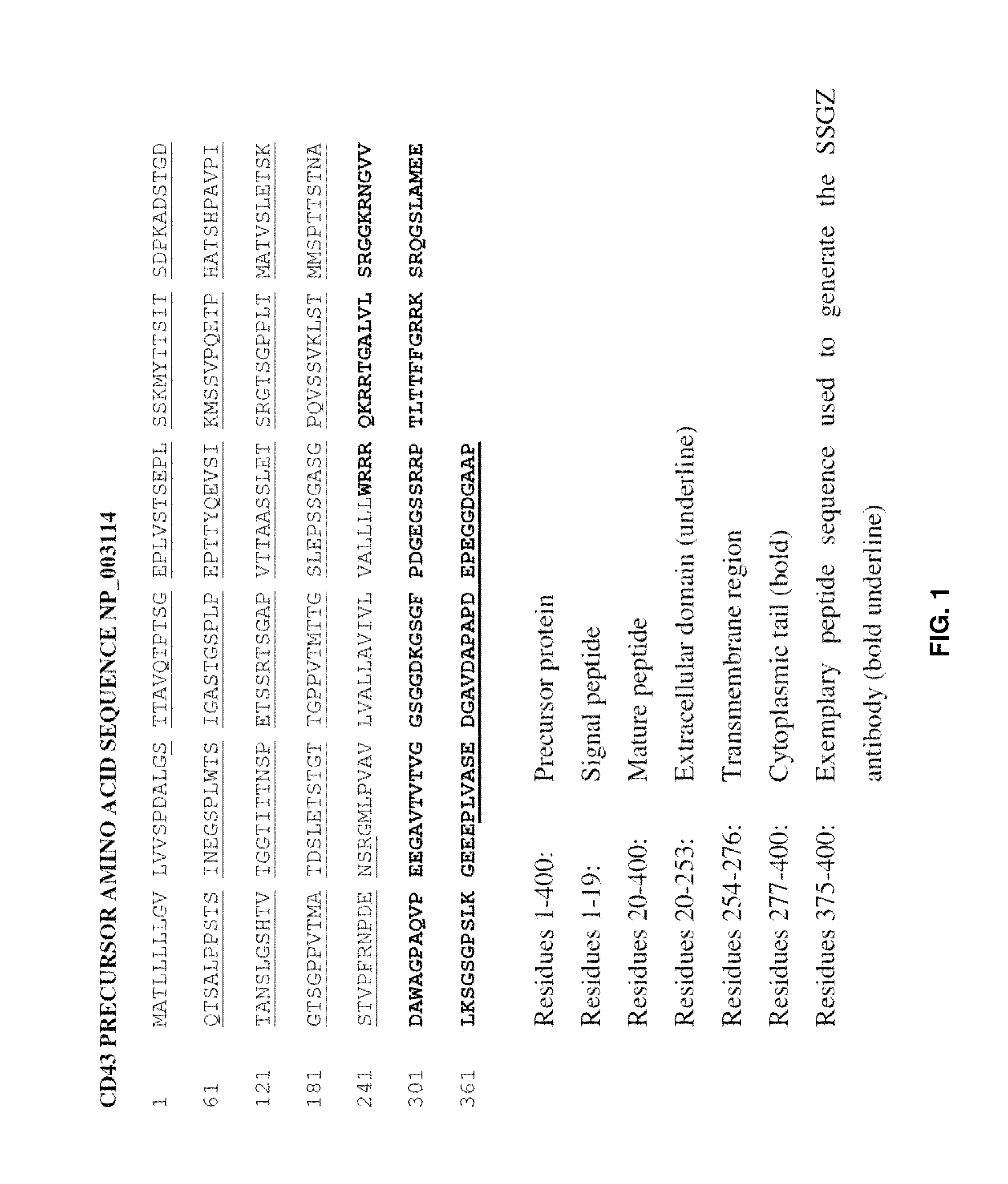Reagents, methods, and kits for the classification of cancer
a technology for cancer and human genital cancer, applied in the field of human genital cancer genital cancer genotypes, can solve the problems of difficult genotype classification, difficult genotype classification,
- Summary
- Abstract
- Description
- Claims
- Application Information
AI Technical Summary
Benefits of technology
Problems solved by technology
Method used
Image
Examples
example 1
Generation of the Polyclonal Antibody SSGZ
[0079]Due to concerns about the antibodies used in previous studies of CD43 expression in cancer cells, we raised a rabbit polyclonal antibody against the terminal 26 amino acids of its intracellular domain. This antibody was named “SSGZ.”
[0080]Covalab S.A.S. (Villeurbanne, France) synthesized a peptide of 26 amino acids with the sequence NH2-PLVASEDGAVDAPAPDEPEGGDGAAP-COOH. This peptide corresponds to residues 375-400 of the primary translation product of CD43 mRNA [3, 4]. These residues are the 26 terminal residues of the intracellular domain of CD43. The same company then used glutaraldehyde cross-linking to conjugate the N-terminus of the peptide to keyhole limpet hemocyanin. Next, 0.5 ml containing 100 μg of the conjugated peptide was mixed with 0.5 ml of Complete Freund Adjuvant, and this was then injected intradermally into a New Zealand White rabbit. After 21 days and then again after 42 days intradermal injection was repeated but wi...
example 2
Verification of CD43 Binding by SSGZ
[0081]SSGZ was tested for CD43 binding using western blot analysis. SSGZ detected a single major protein in extracts of Jurkat T-lymphocytic cells that had an electrophoretic mobility corresponding to the major protein detected by the monoclonal antibody L10 (FIG. 2). The L10 antibody binds the N terminus of CD43 [40].
example 3
[0082]Formalin-fixed paraffin-embedded blocks containing human lung or breast tissue were serially sectioned at 4 μm and dried overnight on Colorfrost® Plus microscope slides (Thermo Fisher Scientific, Inc., Waltham, Mass.). Next, sample slides were deparaffinized by a 60 minute incubation at 60° C. followed by 4 changes of xylene, 3 changes of 100% ethanol, 2 changes of 95% ethanol and storage in tap water. One slide from each block was stained with Hematoxylin and Eosin Y. The remaining slides were subjected to a 20 minute incubation at 90-100° C. in the presence of Epitope Retrieval Solution, pH 9 (Dako North America, Inc., Carpinteria, Calif.). Next, the slides were rocked for 5 minutes at room temperature with tissue covered by the Peroxidase Blocking reagent of the EnVision+System-HRP (DAB) (Dako North America, Inc.). A rocking incubation was then performed at room temperature for 30 minutes with Surfact-Amps® X-100 (Thermo Scientific, Inc., Waltham, Mass.)....
PUM
| Property | Measurement | Unit |
|---|---|---|
| lengths | aaaaa | aaaaa |
| pH | aaaaa | aaaaa |
| morphology | aaaaa | aaaaa |
Abstract
Description
Claims
Application Information
 Login to View More
Login to View More - R&D
- Intellectual Property
- Life Sciences
- Materials
- Tech Scout
- Unparalleled Data Quality
- Higher Quality Content
- 60% Fewer Hallucinations
Browse by: Latest US Patents, China's latest patents, Technical Efficacy Thesaurus, Application Domain, Technology Topic, Popular Technical Reports.
© 2025 PatSnap. All rights reserved.Legal|Privacy policy|Modern Slavery Act Transparency Statement|Sitemap|About US| Contact US: help@patsnap.com



